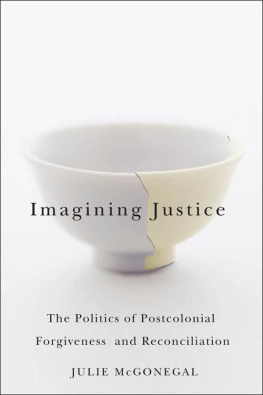Imagining a Greater Justice
Even for violent crime, justice should mean more than punishment. By paying close attention to the relational harms suffered by victims, this book develops a concept of relational justice for survivors, offenders and community. Relational justice looks beyond traditional rules of legal responsibility to include the social and emotional dimensions of human experience, opening the way for a more compassionate, effective and just response to crime.
The books chapters follow a journey from victim experiences of violence to community healing from violence. Early chapters examine the relational harms inflicted by the worst wrongs, the moral responsibility of wrongdoers and common mistakes made in judging wrongdoing. Particular attention is paid here to sexual violence. The book then moves to questions of just punishment: proper sentencing by judges, mandatory sentences approved by the public, and the realities of contemporary incarceration, focusing particularly on solitary confinement and sexual violence. In its remaining chapters, the book looks at changes brought by the victims rights movement and victim needs that current law does not, and perhaps cannot meet. It then addresses possibilities for offender change and challenges for majority America in addressing race discrimination in criminal justice. The book concludes with a look at how individuals might live out the ideals of a greaterrelationaljustice.
Samuel H. Pillsbury is Professor of Law and Frederick J. Lower Fellow at Loyola Law School, Los Angeles. He teaches criminal law, criminal practice and American legal history. A nationally recognized scholar in criminal responsibility, punishment and emotion and the law, his previous books include Judging Evil: Rethinking the Laws of Murder and Manslaughter and How Criminal Law Works. After college, Pillsbury was a reporter covering police and courts in North Florida. He then earned his law degree at the University of Southern California, where he graduated first in his class. He clerked for US District Judge William Matthew Byrne, Jr., and served as an Assistant United States Attorney in Los Angeles before going into teaching. In 2006 he was ordained as an Episcopal deacon. He has volunteered as a chaplain in LA juvenile detention halls and jails, as well as prisons in California and New York. He has also worked with survivors of homicide and families with loved ones in prison.
This is a very important book and I am hopeful it finds a wide readership. Pillsbury has galvanized our imagination of the justice system we actually could have. He manages to get underneath all the issues we need to explore with sophistication, keen insight and great heart. He proposes a point of view both larger and more humble and our country will benefit greatly... if we listen to him.
Gregory Boyle, S.J. Founder of Homeboy Industries. Author of Tattoos on the Heart: The Power of Boundless Compassion.
This is an important piece of scholarship that offers meaningful insights and novel ways of thinking about issues of law, justice and the human condition. It contains numerous aha! passages that inspire head nodding in recognition of the fundamental truths laid bare. The authors style successfully captures legal nuances without being tedious or overly technical. The issues explored could not be more timely; indeed, with recent broad societal recognition of issues of sexual abuse and harassment the prescience of the authors observations border on startling. The discussion of racismparticularly the pervasiveness of unconsciously held attitudes about racecould significantly affect individual attitudes and legal and social policies.
James Acker, Distinguished Teaching Professor, School of Criminal Justice, University at Albany
This lucid and engaging book reconceptualizes criminal law in a fascinating way, drawing together a number of important strands of the discussion that are too often treated separately: criminal law, jurisprudence and philosophy, psychological questions, practical questions of institutional design and even spiritual questions. It also considers topics that are rarely treated in standard criminal law accounts: most particularly the role of the victim. One of the books unusual strengths is that although grounded in legal jurisprudence, it is highly attuned toand comfortable discussingthe emotional aspects of crime and punishment.
Susan A. Bandes, Centennial Professor of Law Emeritus, DePaul University College of Law
I have long admired Samuel Pillsburys writing on crime and punishment for its intellectual rigor and commitment to make the law more just and humane. In Imagining a Greater Justice: Criminal Violence, Punishment and Relational Justice he has produced his most important work. Drawing on law and social science and on his own work with crime victims and offenders, Pillsbury details the complex harms suffered by victims of violence and explores how offenders have come to commit violence. He creatively employs the perspectives of the different vocations he has followedjournalist, attorney, academic and Episcopal deaconto develop a concept of relational justice for crimes of violence. Relational justice includes punishment, but sees justice as finally a community endeavor that should help victims heal and offenders be redeemed. Imagining A Greater Justice challenged some of my own views about crime and punishment; I am confident that it will challenge many others, as the best writing often does.
Jeffrie G. Murphy, Regents Professor of Law, Philosophy, and Religious Studies, Arizona State University
The author is well-positioned to write this book, given his multiple professional commitments and expertise. He clearly brings both knowledge and compassion to the project. Addressing criminal justice through the lenses of punishment and healing for all is an important and innovative approach.
Monica J Casper, Professor of Gender and Womens Studies; Associate Dean for Faculty Affairs, College of Social and Behavioral Sciences, University of Arizona
First published 2019
by Routledge
52 Vanderbilt Avenue, New York, NY 10017
and by Routledge
2 Park Square, Milton Park, Abingdon, Oxon OX14 4RN
Routledge is an imprint of the Taylor & Francis Group, an informa business
2019 Samuel H. Pillsbury
The right of Samuel H. Pillsbury to be identified as author of this work has been asserted by him in accordance with sections 77 and 78 of the Copyright, Designs and Patents Act 1988.
All rights reserved. No part of this book may be reprinted or reproduced or utilized in any form or by any electronic, mechanical, or other means, now known or hereafter invented, including photocopying and recording, or in any information storage or retrieval system, without permission in writing from the publishers.
Trademark notice: Product or corporate names may be trademarks or registered trademarks, and are used only for identification and explanation without intent to infringe.
Library of Congress Cataloging-in-Publication Data
Names: Pillsbury, Samuel H., author.
Title: Imagining a greater justice : criminal violence, punishment, and relational healing / Samuel H. Pillsbury.
Description: 1 Edition. | New York : Routledge, 2019. | Includes index.
Identifiers: LCCN 2018035006 (print) | LCCN 2018053034 (ebook) | ISBN 9780429424922 (Ebook) | ISBN 9781138354173 (hardback) | ISBN 9781138354197 (pbk.) | ISBN 9780429424922 (ebk)














